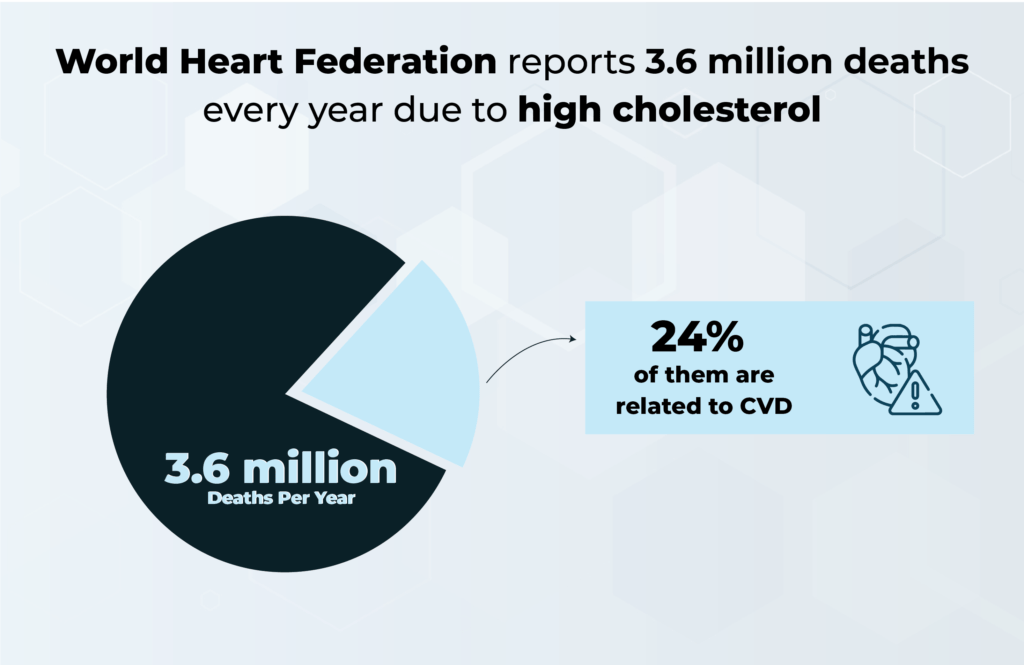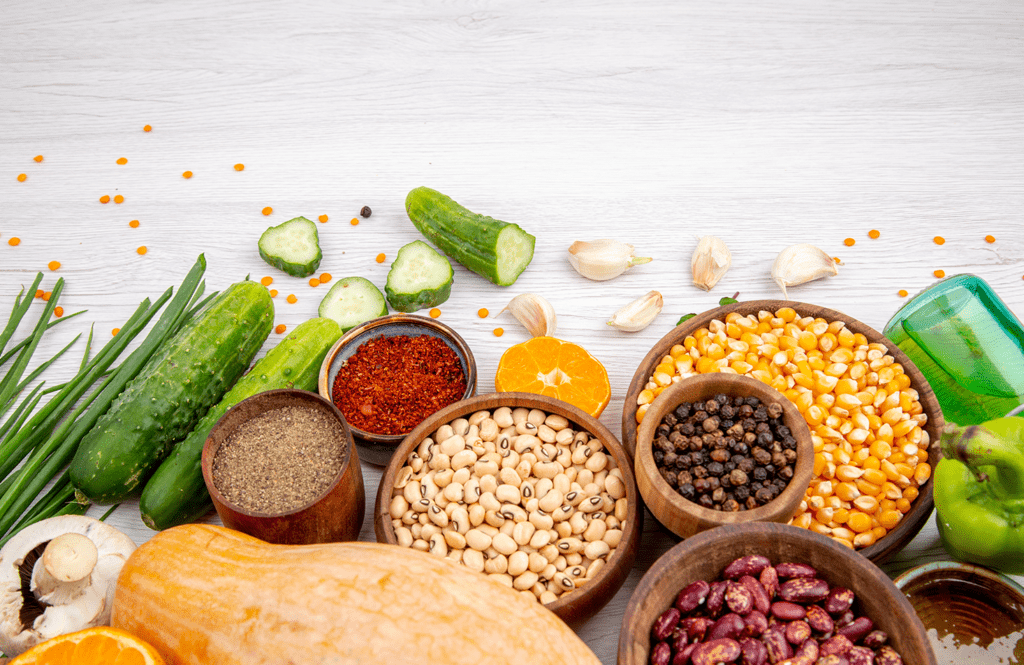We’ve all heard it—high cholesterol is bad for your heart.
It is evident to the World Heart Federation as it reports 3.6 million deaths every year due to high cholesterol and 24% of them are related to CVD. (WHF).

But if you’ve been diagnosed with high cholesterol, it can feel overwhelming to figure out where to begin making changes. You’ve probably searched Google a hundred times, wondering what you can do beyond just popping pills.
The good news? Managing high cholesterol doesn’t have to be an endless list of don’ts. It’s about embracing a heart-healthy lifestyle with simple, practical steps. One powerful way to do that is by adopting the SAAOL (Science and Art of Living) Diet—a unique, comprehensive approach developed by renowned Dr. Bimal Chhajer. This SAAOL way focuses on zero-oil cooking, lifestyle modification, and non-invasive heart treatment like EECP (Enhanced External Counterpulsation).
This blog will walk you through how the SAAOL Diet and Lifestyle can help you manage high cholesterol. We’ll discuss how to use food, exercise, and non-invasive treatments to keep your heart ticking strong. Grab a cozy spot, and let’s dive into this journey toward a healthier heart!
Table of Contents
ToggleWhat Exactly Is Cholesterol, and Why Should You Care?
Before we dive into the SAAOL approach, let’s cover the basics—what is cholesterol, and why should you be concerned if it’s high?
Cholesterol is a fatty substance that your body needs to build cells and produce hormones. Now, you must have heard the terms “good cholesterol” and “bad cholesterol.” It’s like they are some characters from your favorite comics!
But, let’s clear the air for all and ever— THERE IS NO GOOD SIDE OR BAD SIDE OF CHOLESTEROL.
There are 2 main types of this interesting molecule—high-density lipoprotein (HDL) and low-density lipoprotein (LDL) and a VLDL, which stands for very-low-density lipoprotein.
The way these molecules face any discrepancy in their functions OR the way humans treat their bodies (which is why their functions are hindered) affect the body’s metabolism, hence creating cholesterol imbalance that can result in plaque, heart blockage, etc.
However, too much LDL can clog arteries, increasing the risk of heart diseases like heart attacks and strokes. On the flip side, “good” cholesterol (HDL) helps remove excess LDL from your bloodstream. So, your goal is to keep LDL levels low and HDL levels high.
Now, when you hear “high cholesterol,” it’s easy to panic. But before that take a look at these ideal numbers for cholesterol:
Total cholesterol for adults should be less than 200 mg/dL, or milligrams per decilitre.
- Normal: Less than 200 mg/dL
- Borderline: 200–239 mg/dL
- High: 240 mg/dL or higher
Lipid panel|John Hopkins medicine
With the right lifestyle changes, like those promoted by SAAOL, one can naturally lower cholesterol and boost heart health. The key? Taking consistent steps every day that promote a healthier heart.
The Heart of the SAAOL Diet: Zero Oil Cooking
If you’re like most of us, you’ve probably grown up with the idea that oil is a necessary part of cooking. Whether it’s frying up vegetables or drizzling oil on salads, oil has always been a kitchen staple. But here’s the SAAOL twist—you don’t need oil to cook delicious, heart-healthy meals.
Zero-oil cooking is a core component of the SAAOL diet, and it’s as straightforward as it sounds—cooking without oil. Oils, even the so-called “healthy” ones, are 100% fat and can raise LDL cholesterol levels. When you eliminate oil from your diet, you reduce unnecessary fats and calories, leading to better cholesterol levels and overall heart health.
How Does Zero Oil Cooking Work?
It’s much easier than you think! Instead of frying or sautéing food in oil, you can steam, bake, or boil your food. Spices and herbs become your new best friends, adding flavor without the added fats. And guess what? Zero-oil meals can be just as tasty (if not more) than their oily counterparts. With the right techniques, you won’t miss the oil at all!
Example: Think about your favorite curry or stir-fry. Instead of frying onions in oil, you can sauté them in water or vegetable broth. Add some ginger, garlic, and your favorite spices, and boom! You’ve got a flavorful dish without a drop of oil.
SAAOL Diet: What’s on the Plate?

Aside from cutting out oil, the SAAOL diet encourages a plant-based approach with whole grains, millet, vegetables, fruits, and legumes. These foods are naturally rich in fiber, which helps lower LDL cholesterol levels. It’s all about going back to basics—natural, unprocessed, and plant-based foods.
Here’s a glimpse of what the SAAOL plate looks like:
- Vegetables: Aim for a variety of colorful veggies like spinach, carrots, broccoli, and tomatoes.
- Whole Grains: Opt for fiber-rich grains like brown rice, oats, quinoa, and whole wheat.
- Fruits: Enjoy a rainbow of fruits, from berries to bananas and apples.
- Legumes: Chickpeas, lentils, and beans are great plant-based protein sources that help lower cholesterol.
Beyond Diet: The Power of EECP Treatment
If you’ve been struggling with high cholesterol and are looking for a more comprehensive approach, EECP treatment might be the solution. EECP, or Enhanced External Counterpulsation, is a non-invasive heart treatment that improves blood flow to the heart and helps reduce the symptoms of heart disease.
How Does EECP Work?
During EECP, large cuffs are placed around your legs, and they rhythmically inflate and deflate to pump blood more efficiently toward your heart. This helps open up collateral arteries or simply put alternate channels over time, improving the oxygen supply to the heart and reducing the workload on it.
Who Can Get EECP Treatment?
Patients with the following conditions benefit most from EECP therapy:
- Angina: Chest pain brought on by insufficient blood supply to the heart.
- Heart Failure: Individuals seeking better and a higher standard of living due to compromised heart function.
- Cardiovascular Disease: People seeking minimally invasive means of treating coronary artery blockages.
For people with high cholesterol and existing heart conditions, EECP treatment is a game-changer. It’s a safe, non-invasive alternative to procedures like angioplasty or bypass surgery, and it can dramatically improve your heart’s function.
Bonus: EECP is a painless procedure, typically done over a few weeks, making it an easy addition to your heart health plan.
Lifestyle Modifications: Small Changes, Big Impact
One of the pillars of the SAAOL approach is making lifestyle modifications that not only lower cholesterol but improve overall well-being. These changes may seem small, but when done consistently, they can make a huge difference.
- Exercise
You don’t need to run a marathon to improve your cholesterol levels. Even moderate physical activity, like brisk walking, swimming, or yoga, can raise your HDL and lower your LDL. Aim for at least 30 minutes of exercise five days a week. Think of it as movement medicine for your heart!
- Stress Management
Stress is a major contributor to heart disease, and high cholesterol can be worsened by chronic stress. Incorporating stress-relief practices like meditation, deep breathing exercises, and mindfulness can lower stress levels, which in turn helps keep your heart healthy.
- Quit Smoking
If you smoke, quitting is one of the best things you can do for your heart. Smoking lowers HDL cholesterol and damages the walls of your arteries. Within weeks of quitting, your HDL levels will start to improve, and your heart will thank you.
- Regular Check-ups
While diet and exercise are crucial, it’s also important to monitor your cholesterol levels through regular health check-ups. CSI (Cardiologists Society of India) recommends starting your lipid profile screening right from the age of 18. (CSI guidelines). By tracking your progress, you can make adjustments to your lifestyle as needed and stay on top of your heart health.
It is A Journey, Not a Sprint
The transformative power of the SAAOL approach is more than just a diet—it’s a lifestyle shift. It may seem daunting at first to make changes like zero-oil cooking or committing to regular exercise but remember, it’s a journey, not a sprint. The SAAOL approach is about consistency and creating habits that support your heart health in the long run.
There’s no one-size-fits-all solution to managing high cholesterol, but by embracing a holistic lifestyle—from your diet to your daily habits—you can take control of your heart health.
So, if you’ve been looking for ways to manage your cholesterol naturally, why not give the SAAOL approach a try? Your heart will thank you for it!


